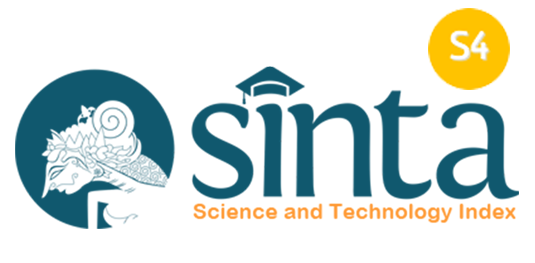Implementation of learning video on mathematical analogic thinking ability in solving pythagoras theorem problems
Abstract
The problem in this study is related to the low ability to think mathematically analogies of junior high school students which can be seen when students work on the board they are still confused about which formula to use, and if they can determine which formula to use the numbers or questions that are included in the formula are not appropriate. Because teachers tend to be preoccupied with how to ensure that all material can be delivered based on the time allocation available. This makes students understand a little mathematical concepts, whether it's related to the formula used, how to do it, and even some children tend to not understand what material is conveyed by the teacher. One solution to this problem is the use of video-based learning media that students can access at any time. This research is a qualitative research. The results of this study were students with low ability to think mathematically analogies (A1) were unable from the start, at the encoding, inferring, mapping and applying stages. Students with moderate mathematical analogy thinking skills (A2) were able to pass the encoding and inferring stages but failed at the mapping and applying stages. Students with high mathematical analogy thinking skills (A3) were able to pass the encoding, inferring, and mapping stages but failed at the applying stage. This proves that there are still students who are less able to think mathematical analogies even though they have been assisted by the use of learning video media.
Keywords
Full Text:
PDFReferences
Agustina, Dwi. (2022). “Kemampuan Penalaran Analogi Matematis Di Indonesia: Systematic Literature Review”, Symmetric Journal. Vol. 7 No. hal. 7
Andriani, D., Widada, W., Herawaty, D., Ardy, H., Nugroho, K. U. Z., Ma’rifah, N., … Anggoro, A. F. D. (2020). Understanding the number concepts through learning Connected Mathematics (CM): A local cultural approach. Universal Journal of Educational Research, 8(3), 1055–1061. https://doi.org/10.13189/ujer.2020.080340
Astuti, Y., & Mustadi, A. (2014). Pengaruh Penggunaan Media Film Animasi Terhadap Keterampilan Menulis Karangan Narasi Siswa Kelas V SD. Jurnal Prima Edukasia, 2(2), 250-262. Retrieved from http://journal.uny.ac.id/index.php/jpe/arti cle/view/2723
Delyana, H. (2015). Peningkatan Kemampuan Pemecahan Masalah Matematika Siswa Kelas VII Melalui Penerapan Pendekatan Open-Ended.Vol 2 No 1. Program Studi Pendidikan Matematika STKIP PGRI Sumatra Barat.
Djamaluddin, Ahdar. (2019). Belajar dan Pembelajaran. Pare-Pare : CV. Kaaffah Learning Center, CV. Kaaffah Learning Center
Harahap, E.R., & Surya, E. (2017). Kemampuan Pemecahan Masalah Matematis Siswa Kelas VII Dalam Menyelesaikan Persamaan Linear Satu Variabel. Vol 7 Nomor 1. April 2017. Prodi Pendidikan Matematika UNIMED.
Herawaty, D, & Widada, W. (2018). The Influence of Contextual Learning Models and the Cognitive Conflict to Understand Mathematical Concepts and Problems Solving Abilities. Advances in Social Science, Education and Humanities Research, 218(ICoMSE 2017), 96–102. https://doi.org/10.2991/icomse- 17.2018.17
Keban, Y. B. (2022). Pendidikan Karakter, Teknologi Informasi, era society 5.0 56. Reinha, 13(1), 62.
Komara, E. (2014). Belajar dan Pembelajaran Interaktif. Bandung : PT. Refika Aditama.
Nugroho, K. U. Z., Widada, W., & Herawaty, D. (2019). The Ability To Solve Mathematical Problems Through Youtube Based Ethnomathematics Learning. International Journal of Scientific & Technology Research, 8(10), 1232–1237.
Layali,N.K. & Masri. Kemampuan Pemecahan Masalah Matematis Melalui Model Treffinger di SMA, jurnal pendidikan matematika rafflesia, Vol. 05 No. 02, Juni 2020, hal 138
Nur Safrida, Lela dkk . (2015). “Analisis Proses Berpikir Siswa Dalam Pemecahan Masalah Terbuka Berbasis Polya Sub Pokok Bahasan Tabung Kelas Ix Smp Negeri 7 Jember”, Jurnal Kadikma, Vol. 6, No. 1, (April,) hal 14
Rahma, Sitti dkk. (2022). Implementasi Video Pembelajaran Matematika Untuk Meningkatkan Kemampuan Penalaran Matematis Peserta Didik, 1(1), 36
Rendrayana, K., Suarsana, I. M., & Parwati, N. N. (2020). Strategi Pembelajaran Analogi dan Kemampuan Pemahaman Konsep Matematika. Jurnal Pendidikan Matematika , 6(1), 15–27.
Ramdhayani, E., Ibrahim, M., & Madlazim, M. (2017). Pembelajaran Sikap Melalu Analogi Dalam Mengajarkan Biologi. JPPS (Jurnal Penelitian Pendidikan Sains), 5(1), 874. https://doi.org/10.26740/jpps.v5n1.p874-884 Rendrayana K.. I. M.,
Suarsana & Parwati, N. N. (2020). Strategi Pembelajaran Analogi dan Kemampuan Pemahaman Konsep Matematika. (Jurnal Pendidikan Matematika,Vol. 6 No. 1 hal. 15–27.
Russeffendi, E.T. (2010). Dasar-Dasar Penelitian Pendidikan dan Bidang Non- Eksakta Lainnya. Bandung: Tarsito.
Shoimin, Aris. (2014). Model Pembelajaran Inovatif dalam kurikulum 2013. Jogjakarta : AR-RUZZ MRDIA Suryansyah.
Titi dan Suwarjo. (2016) Pengembangan Video Pembelajaran Untuk Meningkatkan Motivasi dan Hasil Belajar Kognitif Siswa Kelas IV SD. Jurnal Prima Edukasia, 4 (2), 209 - 221.
Ulva, Shovia. (2016). Kemampuan Pemecahan Masalah Matematis Siswa ditinjau melalui model SAVI dan Konvensional. Vol.2 No.2. Program Studi Pendidikan Matematiks, STKIP Garut.
Yusuf, Munir. (2018). Ilmu Pengantar Pendidikan. Palopo: Lembaga Penerbit Kampus IAIN Palopo.
DOI: https://doi.org/10.18860/ijtlm.v6i1.22254
Refbacks
- Implementation of learning video on mathematical analogic thinking ability in solving pythagoras theorem problems
- Implementation of learning video on mathematical analogic thinking ability in solving pythagoras theorem problems
- Implementation of learning video on mathematical analogic thinking ability in solving pythagoras theorem problems
- IMPLEMENTATION OF LEARNING VIDEO ON MATHEMATICAL ANALOGIC THINKING ABILITY IN SOLVING PYTHAGORAS THEOREM PROBLEMS
- Implementation of learning video on mathematical analogic thinking ability in solving pythagoras theorem problems
- Implementation of learning video on mathematical analogic thinking ability in solving pythagoras theorem problems
Copyright (c) 2023 Laily Nur Rahma

This work is licensed under a Creative Commons Attribution-NonCommercial-ShareAlike 4.0 International License.
Indexed by :
.png)
.jpg)
.png)

.jpg)


